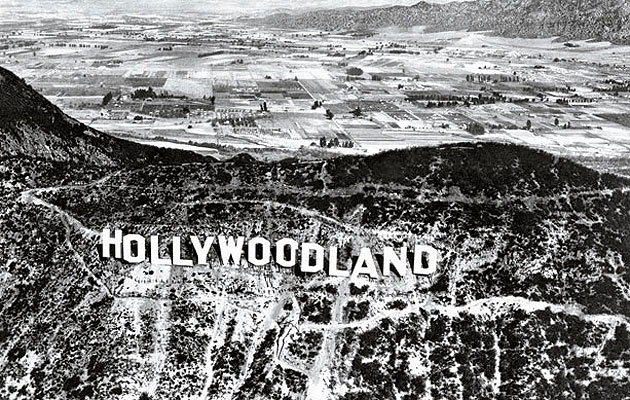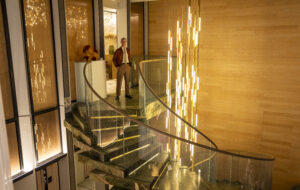|
The original 1923 sign was an advert for a property development (image: From Taschen’s Los Angeles: Portrait of a City, by Jim Heiman and Kevin Starr) |
||
|
When we think of cities we think of skylines, just as mappers in the Renaissance did when they drew bird’s eye views of towns dominated by church steeples. Los Angeles is a curious exception, a major city with no skyline of note. There is downtown, of course, but the skyscrapers are dull products of postmodern speculation – and luckily on most days the smog hides them. In part LA has become a prototype for the late-20th-century generic city, like Phoenix or San José, in which horizontal sprawl wins out and a real skyline fails to emerge. LA does have an icon, but it’s certainly not Frank Gehry’s Walt Disney Concert Hall, which huddles below downtown and is itself a universal response that could be anywhere. Instead, the city’s skyline is a scrub-covered hill upon which sits a sign spelling out “HOLLYWOOD” in 14m-tall letters. Built in 1923 out of sheet metal mounted to telephone poles and covered with flashing lights, the sign initially read “HOLLYWOODLAND”, advertising a property development of the same name. Although intended to be temporary, the sign proved popular and was left up. By the 1940s, it fell into disarray; the city took over the sign, repairing it while eliminating the last four letters. With LA reaching another low point in the 1970s, the sign once again fell into disrepair. A group of interested locals – among them performers Alice Cooper, Gene Autry and Andy Williams, and Playboy founder Hugh Hefner – funded a complete rebuild, one metre shorter than the original but made from more permanent materials. The sign came to be a symbol not just for the neighbourhood but also the city. Notwithstanding that LA was the nation’s largest centre for defence production in the postwar era, it was the glamour and power of Hollywood that the city identified with. The media industry was power, not just in the United States but also abroad, an indirect but effective instrument of American capital, spreading the American way throughout the world. With the end of the Cold War, manufacturing in the LA basin collapsed. Construction and real estate, tourism, entertainment and trade through the ports were the major players in the city’s economy throughout the last two decades – but with the economy in crisis, the city has suffered a major downturn that may yet make the bad days of the early 1990s look rosy in comparison. Once capable of providing escapism, the media industry now seems more interested in escaping to other states and countries offering less union labour and more lucrative tax credits. Over the years, the sign has proven irresistible to pranksters, who have altered it to read “HOLLYWEED” and “CALTECH”. This spring, the sign was covered with the letters “SAVE THE PEAK” by preservationists concerned that private land immediately adjacent to it would be sold and promptly built upon. A telecommunications antenna next to the sign already mars the view. Even if actress Charlize Theron, who lives nearby, once remarked that the antenna was a better symbol of Hollywood than the sign, there’s little question that these letters most aptly represent the city. A product of speculation, frivolous, somewhat decrepit but nevertheless iconic, what better monument for the movie industry and the city it adopted as its home? |
Words Kazys Varnelis |
|
|
||


















